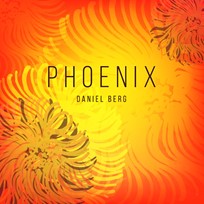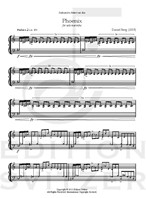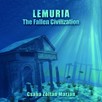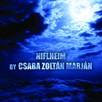Item details
-
Description +
-
Duration: 5 min.
Half gold and half red phoenix is reborn after every 500 years. This mysterious bird has different meanings in different cultures. In Greek mythology, the Phoenix built a nest of aromatic twigs and set herself on fire. Three days after the death, she resurrected from the ashes. The Chinese empress was the only person who could carry the symbol of the Phoenix, and therefore associated with the feminine energy, while the dragon represented the male - the union of yin and yang. In the Japanese culture is the bird Phoenix along with the rising sun symbol of the immortal and is called "Ho-o" - the immortal bird.
When I wrote Blue Memories a couple of years ago, I chose an enamel painting by Swedish artist, Bengt Berglund from late 60's as cover for the work. This painting I chose is part of a series of other enamel paintings by Berglund. For a few years now, I have been thinking of writing music for the remaining paintings in the series. Phoenix, Helios, Twilight Garden and Blue Memories are related to each other in terms of harmony, rhythm and character. The four pieces are written as standalone pieces, however the four pieces works well together as one substantial piece with several movements in it.
Daniel Berg studied with the marimba virtuoso Robert van Sice at the Rotterdams Conservatorium, Holland (Europe’s first diploma program for solo marimba), 1993-1997. As a big thank Daniel dedicates this piece to his professor!
-
-
Instrumentation +
-
Marimba
-
-
Watch+
-
Performed by Daniel Berg:
-
-
About the composer +
-
Daniel Berg is a Swedish composer, musician, and professor in classical percussion at the Royal College of Music in Stockholm and at the Academy of music and drama in Gothenburg.
In his passion to promote the marimba as a solo- and chamber music instrument, Daniel has worked intimately with a number of composers who have written original music for the instrument. This includes more than 300 world premier for solo and chamber works. Daniel Berg is a marimba artist of Bergerault and Elite Mallets.
As a composer Daniel has written a lot for solo marimba like Mistral (for Michael Burritt), Phoenix (for Robert van Sice) and Yán Jiâng (for the Taiwan World Percussion Competition). His music for percussion ensemble have been appreciated and often performed like Kroumata (for sextet) and Arctic Nights (for quintet) - all published by Edition Svitzer.
-
-
Reviews +
-
Percussive Notes, November 2016
“Phoenix” is the fourth work in a series of marimba solos based on the paintings of Swedish artist Bengt Berglund. All four pieces have musical connections to each other with regard to harmony, rhythm, and the character of the works. As the composer states, “The four pieces are written as stand-alone pieces, however the four pieces works [sic] well together as one substantial piece with several movements in it.”
Opening with some forte-piano gestures, the piece then moves away to a more linear style of writing for the next phrases before returning to the opening motive again. Much of the material repeats itself, but with enough variation to keep the material fresh. This type of repetition makes the piece feel like a rondo form of sorts with the opening material returning after each departure. Each section has its own character, while at the same time still feeling connected to the piece as a whole.
The piece is relatively aggressive in nature with its “Furioso” tempo indication and perpetual-motion style of writing. However, there are areas even within this framework where the performer can pull back to show subtle notions of touch and musicality. Overall this middle section allows for enough diversity to make the piece work and not feel like a repetitive flurry of notes throughout.
“Phoenix” is a well-constructed composition that provides enough depth compositionally and musically to be a welcome addition to the repertoire. Clocking in at just under three minutes, it would work well as an encore piece for an undergraduate recital or with the other works in the series for a substantial section of a performance.
—Brian Nozny
-
-
Credits +
-
Front Cover layout: Gaia Gomes
Enamel painting: Bengt Berglund
Photo: Per Buhre
Engraving: Johan Svitzer
Printed in Copenhagen, Denmark
Copyright © Edition SVITZER
www.editionsvitzer.com
-








